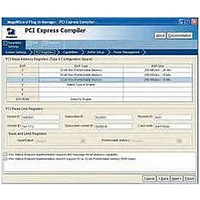IPR-PCIE/1 Altera, IPR-PCIE/1 Datasheet - Page 321

IPR-PCIE/1
Manufacturer Part Number
IPR-PCIE/1
Description
IP CORE Renewal Of IP-PCIE/1
Manufacturer
Altera
Type
MegaCorer
Specifications of IPR-PCIE/1
Software Application
IP CORE, Interface And Protocols, PCI
Supported Families
Arria GX, Cyclone II, HardCopy II, Stratix II
Core Architecture
FPGA
Core Sub-architecture
Arria, Cyclone, Stratix
Rohs Compliant
NA
Function
PCI Express Compiler, x1 Link Width
License
Renewal License
Lead Free Status / RoHS Status
na
Lead Free Status / RoHS Status
na
- Current page: 321 of 362
- Download datasheet (7Mb)
Chapter :
Descriptor/Data Interface
Table B–8. Advanced TX Data Phase Signals
Table B–9. tx_cred0[21:0] Bits for the ×1 and ×4 IP cores (Part 1 of 2)
December 2010 Altera Corporation
tx_cred<n>[65:0]
tx_err<n>
Note to
(1) For all signals, <n> is the virtual channel number which can be 0 or 1.
[0]
[9:1]
[10]
(1)
Bits
Table
Signal
B–8:
■
■
■
■
■
■
■
0: No credits available
1: Sufficient credit available for at
least 1 transaction layer packet
0: No credits available
1-256: number of credits available
257-511: reserved
0: No credits available
1: Sufficient credit available for at
least 1 transaction layer packet
Table B–8
Table B–9
I/O
O
I
Value
Transmit credit. This signal controls the transmission of transaction layer packets of a
particular type by the application layer based on the number of flow control credits
available. This signal is optional because the IP core always checks for sufficient credits
before acknowledging a request. However, by checking available credits with this signal, the
application can improve system performance by dividing a large transaction layer packet
into smaller transaction layer packets based on available credits or arbitrating among
different types of transaction layer packets by sending a particular transaction layer packet
across a virtual channel that advertises available credits. Each data credit is 4 dwords or 16
bytes as per the PCI Express Base Specification. Refer to
a transaction layer packet is acknowledged by the IP core, the corresponding flow control
credits are consumed and this signal is updated 1 clock cycle after assertion of tx_ack.
For a component that has received infinite credits at initialization, each field of this signal is
set to its highest potential value.
For the ×1 and ×4 IP cores this signal is 22 bits wide with some encoding of the available
credits to facilitate the application layer check of available credits. Refer to
details.
In the ×8 IP core this signal is 66 bits wide and provides the exact number of available
credits for each flow control type. Refer to
Refer to
Transmit error. This signal is used to discard or nullify a transaction layer packet, and is
asserted for one clock cycle during a data phase. The IP core automatically commits the
event to memory and waits for the end of the data phase.
Upon assertion of tx_err, the application interface should stop transaction layer packet
transmission by deasserting tx_dfr and tx_dv.
This signal only applies to transaction layer packets sent to the link (as opposed to
transaction layer packets sent to the configuration space). If unused, this signal can be tied
to zero. This signal is not available in the ×8 IP core.
describes the advanced data phase signals.
shows the bit information for tx_cred<n>[21:0] for the ×1 and ×4 IP cores.
Table B–9
for the layout of fields in this signal.
Posted header.
Posted data: 9 bits permit advertisement of 256 credits, which
corresponds to 4 KBytes, the maximum payload size.
Non-Posted header.
Description
Table B–10
Description
for details.
Table B–9
PCI Express Compiler User Guide
for the bit details.Once
Table B–9
for
B–15
Related parts for IPR-PCIE/1
Image
Part Number
Description
Manufacturer
Datasheet
Request
R

Part Number:
Description:
IP CORE Renewal Of IP-PCI/MT32
Manufacturer:
Altera
Datasheet:

Part Number:
Description:
IP CORE Renewal Of IP-PCI/MT64
Manufacturer:
Altera
Datasheet:

Part Number:
Description:
IP CORE Renewal Of IP-PCI/T32
Manufacturer:
Altera
Datasheet:

Part Number:
Description:
IP CORE Renewal Of IP-PCI/T64
Manufacturer:
Altera
Datasheet:

Part Number:
Description:
IP CORE Renewal Of IP-PCIE/4
Manufacturer:
Altera
Datasheet:

Part Number:
Description:
IP CORE Renewal Of IP-PCIE/8
Manufacturer:
Altera
Datasheet:

Part Number:
Description:
IP NIOS II MEGACORE RENEW
Manufacturer:
Altera
Datasheet:

Part Number:
Description:
IP CORE Renewal Of IP-XAUIPCS
Manufacturer:
Altera
Datasheet:

Part Number:
Description:
CPLD, EP610 Family, ECMOS Process, 300 Gates, 16 Macro Cells, 16 Reg., 16 User I/Os, 5V Supply, 35 Speed Grade, 24DIP
Manufacturer:
Altera Corporation
Datasheet:

Part Number:
Description:
CPLD, EP610 Family, ECMOS Process, 300 Gates, 16 Macro Cells, 16 Reg., 16 User I/Os, 5V Supply, 15 Speed Grade, 24DIP
Manufacturer:
Altera Corporation
Datasheet:

Part Number:
Description:
Manufacturer:
Altera Corporation
Datasheet:










